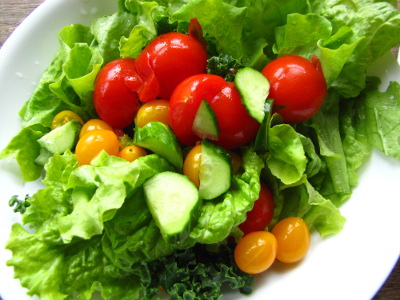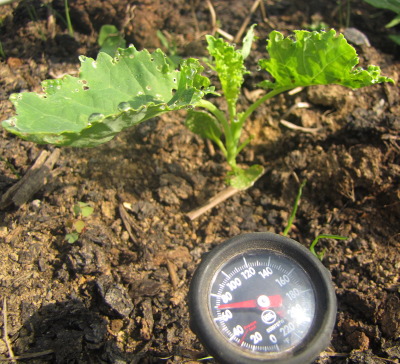
Maximum soil temperatures for germination
 When
I realized that soil
temperature was the limiting
factor keeping spring crops from sprouting early, I felt like I'd
discovered the scientific way to time my spring plantings. I
probably should have realized that there was a flip side to the soil
temperature coin --- many fall crops have trouble germinating in hot
summer soil.
When
I realized that soil
temperature was the limiting
factor keeping spring crops from sprouting early, I felt like I'd
discovered the scientific way to time my spring plantings. I
probably should have realized that there was a flip side to the soil
temperature coin --- many fall crops have trouble germinating in hot
summer soil.
| Vegetable |
Optimum
temp. (degrees F) |
Maximum
temp. (degrees F) |
| Beans, Snap |
80 |
95 |
| Cabbage |
85 |
100 |
| Carrots |
80 |
95 |
| Corn |
95 |
105 |
| Cucumbers |
95 |
105 |
| Lettuce |
75 |
85 |
| Muskmelons |
90 |
100 |
| Okra |
95 |
105 |
| Onions |
75 |
95 |
| Parsley |
75 |
90 |
| Peas |
75 |
85 |
| Peppers |
85 |
95 |
| Pumpkins |
95 |
100 |
| Spinach |
70 |
85 |
| Squash |
95 |
100 |
| Swiss chard |
85 |
95 |
| Tomatoes |
85 |
95 |
| Turnips |
85 |
105 |
| Watermelons |
95 |
105 |
This summer has been considerably warmer than average, but I assumed that as long as I kept my fall plantings well watered, they would grow. Not so. I managed to sprout a single spinach seedling out of three beds, only a third of my peas came up, and I wasn't able to germinate Asian greens and lettuce until I planted new areas at the shady end of the mule garden.
 I finally thought to pull out
my soil thermometer one morning at the end of August, at which time I
discovered that the earth's temperature two inches down ranged from 65
degrees Fahrenheit in the more shaded front garden to 68 degrees
Fahrenheit in the sunny mule garden. Checking back at 6 PM when
the sun had pounded down all day, the mule garden soil temperature had
risen to 81 degrees. Yes, mulched spots were considerably cooler
--- clocking in at the low to mid seventies --- but my fall plantings
have all gone into bare soil since the seedlings are too small to push
aside mulch. A few weeks earlier when I was vainly planting
spinach seeds, I suspect the daytime soil highs easily exceeded the 85
degree Fahrenheit absolute upper limit for spinach germination.
I finally thought to pull out
my soil thermometer one morning at the end of August, at which time I
discovered that the earth's temperature two inches down ranged from 65
degrees Fahrenheit in the more shaded front garden to 68 degrees
Fahrenheit in the sunny mule garden. Checking back at 6 PM when
the sun had pounded down all day, the mule garden soil temperature had
risen to 81 degrees. Yes, mulched spots were considerably cooler
--- clocking in at the low to mid seventies --- but my fall plantings
have all gone into bare soil since the seedlings are too small to push
aside mulch. A few weeks earlier when I was vainly planting
spinach seeds, I suspect the daytime soil highs easily exceeded the 85
degree Fahrenheit absolute upper limit for spinach germination.So what's the solution for getting fall vegetables to germinate in the middle of a hot summer? Lowering soil temperature is probably the reason that some old gardening books recommend placing mulch or old boards over your fall plantings --- you just have to remember to uncover your seedlings as soon as they sprout. Another option is to plant fall vegetables in a cool, shady location, but that idea will backfire when winter cold nips those spots early. Perhaps shady beds could be used as nursery plots for larger fall vegetables, and the seedlings transplanted out into the main garden later? Or maybe there's a way to rig shade cloths to keep the soil temperature in range? I'd be interested to hear how those of you who live with this sort of summer weather every year get your fall garden to sprout.
Want more in-depth information? Browse through our books.
Or explore more posts by date or by subject.
About us: Anna Hess and Mark Hamilton spent over a decade living self-sufficiently in the mountains of Virginia before moving north to start over from scratch in the foothills of Ohio. They've experimented with permaculture, no-till gardening, trailersteading, home-based microbusinesses and much more, writing about their adventures in both blogs and books.
Want to be notified when new comments are posted on this page? Click on the RSS button after you add a comment to subscribe to the comment feed, or simply check the box beside "email replies to me" while writing your comment.

I water the bed to be seeded with cold spring water, and plant the seeds when the sun is not directly on the bed. Then I put four chunks of firewood at the corners, and lay a sheet of plywood over the bed. I suppose I could just lay it directly on the bed though. I just thought the airspace might prevent conductive heating. But then again, plywood doesn't conduct heat all that well...
I think that planting the seeds in the evening is better, since they will have about 12 hours at germination temperature before it warms up again. I have no data to back that one up though.
Anonymous --- I like that idea a lot. I'm not sure if row cover fabric would keep the soil cool enough though. Not sure what would be better....
Jackie --- That's an awesome idea! The okra in front of it was probably part of why my one bed of Asian greens sprouted so well.
I haven't had great luck with row cover fabric, either directly on the ground or on hoops, cooling the soil enough for germination. But after having radish and lettuce seed languish ungerminated under it for three weeks this summer, I gave up and transplanted bok choys into the bed and mulched them with straw. I had thin row cover suspended on hoops above them (not extending all the way to the ground so as to allow air movement). The seed unexpected germinated where the soil had not been disturbed and had no trouble pushing through the one to two inches of straw between the transplants. I've subsequently experimented and found that straw from a native wheat grass that grows in a meadow here in northern New Mexico works better than wheat straw from bales. It's thinner stemmed and sort of mats together a bit, so a thinner layer will do, though I'm experimenting with thicker layers also. I've planted lettuce, spinach, radishes, beets, chard, peas, arugula, and various bok choys several times since and gotten 60% (peas, spinach) to 90% (arugula, bok choys) germination.
I was also able to get decent germination with a mix of cow peas and vetch broadcast in early July over an area next to my garden where I scratched the dry as a bone soil with a garden rake. I'd already whacked down the native yellow clover that grows sporadically there, and the summer rains hadn't come yet--no precipitation since a snow/rain on May 2--and the native grasses and weeds, that grow in patches there were still dormant. After broadcasting I threw down a couple of inches of my native straw. The next day we got almost an inch of rain and have gotten enough more sporadically since--three inches total--that I got a decent stand that competes well with the perennials but I've weeded the vigorous annuals that sprouted in that little oasis of damp soil. About ten days ago I similarly broadcast another pea/vetch mixture and included daikon radish and a variety of cool weather veggies. Some peas and choys are popping up and it's rained sporadically the last couple of days so I expect more surprises daily.
Mulch is great. Necessary here to preserve soil moisture. I take the soil temps sporadically and mulch can keep the ground ten degrees or more cooler (I don't have air temps as high as most, but the solar radiation is intense at almost 8000 feet elevation). I was pleasantly surprised that little seedling can punch through as well as what I've seen so far.
Roland --- I'm looking for something that's both modular and reusable, so that I can use the same shade setup on different beds in different years. That nixes your first three suggestions. The fourth suggestion is a great permaculture use of the sunny space, but probably more effort that I have at that time of the year. Quick and dirty is the way to go with summer projects.
Walter --- I'm so glad you shared your experience with seedlings under mulch. The truth is that the few things I've had great luck sprouting at that time of year were cover crops and I started them all under light layers of straw. So maybe I should just experiment with doing the same with my fall vegetables --- sure, the seedlings are smaller, but maybe I'm not giving them enough credit.